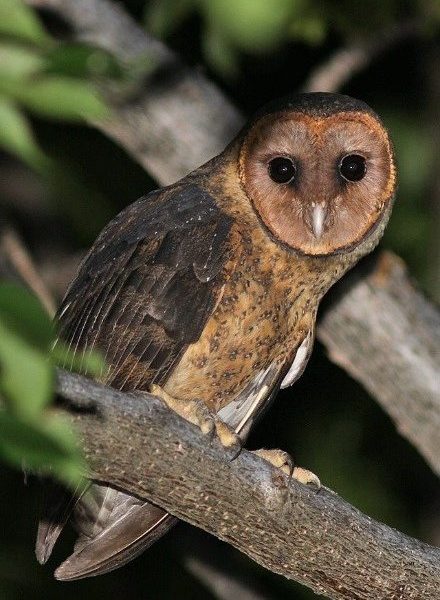Tytonidae: Barn Owls
The barn owls are a distinctive branch of the owl family tree that is believed to have diverged from the lineage of “typical owls” (Strigidae) approximately 47 million years ago. They are regarded as distinct from typical owls due to certain skeletal differences: an elongated skull and bill; the sternum and furcula (wishbone) fused together; and an elongated inner toe with a serrated claw.
Many members of the Tytonidae habitually roost and nest in caves and have transferred this preference to various kinds of manmade structures—especially barns and churches that have open transoms for ventilation and often have resident rodent populations. The name “barn owl” is therefore apt even though it reflects an anthropogenic trait of the family.
Taxonomy
The Tytonidae comprise approximately 27 to 37 species in two subfamilies: Phodilinae (bay owls; 2 species) and Tytoninae (barn owls; 25 to 35 species). Each subfamily is a single genus with strong similarities among species. Members of the cosmopolitan Tyto have a strongly defined heart-shaped facial disk, small eyes, and notably long legs, whereas the two Asian Phodilus have a U-shaped facial disk and large eyes.
The internal taxonomy of Tyto is unsettled, and it seems likely that several additional species will eventually be recognized. Genetic analyses have shown that the Old World and New World forms of the cosmopolitan Barn Owl (Tyto alba) are more closely related to other species than to one another, and that what was traditionally considered to be a single species consists of three main lineages: the Western Barn Owl (T. alba) of Europe, Africa and northern Asia, the Eastern Barn Owl (T. javanica) of tropical Asia, Wallacea and Australia, and the American Barn Owl (T. furcata) of the Americas. The emerging consensus is that, at a minimum, those three groups are separate species, and that several of the divergent island forms should also be recognized as separate species. The current count of species that until recently were classified together as T. alba lies somewhere between three and eighteen.
Oriental Bay Owl (Phodilus badius)
Sri Lanka Bay Owl (Phodilus assimilis)
Itombwe Owl (Tyto prigoginei)
Minahasa Masked Owl (Tyto inexspectata)
African Grass Owl (Tyto capensis)
Eastern Grass Owl (Tyto longimembris)
Greater Sooty Owl (Tyto tenebricosa)
Lesser Sooty Owl (Tyto multipunctata)
Golden Masked Owl (Tyto aurantia)
Manus Masked Owl (Tyto manusi)
Australian Masked Owl (Tyto novaehollandiae)
“Australian Masked Owl” (T. n. novaehollandiae)
“Tasmanian Masked Owl” (T. n. castanops)
Seram Masked Owl (Tyto almae)
Lesser Masked Owl (Tyto sororcula)
“Buru Masked Owl” (T. s. cayelii)
“Tanimbar Masked Owl” (T. s. sororcula)
Red Owl (Tyto soumagnei)
Sulawesi Masked Owl (Tyto rosenbergii)
Taliabu Masked Owl (Tyto nigrobrunnea)
Andaman Barn Owl (Tyto deroepstorffi)
Eastern Barn Owl (Tyto javanica)
“Eastern Barn Owl” (T. j. javanica)
“Boang Barn Owl” (T. j. crassirostris)
São Tomé Barn Owl (Tyto thomensis)
Cape Verde Barn Owl (Tyto detorta)
Madeira Barn Owl (Tyto schmitzi)
Slender-billed Barn Owl (Tyto gracilirostris)
Western Barn Owl (Tyto alba)
“Eurasian Barn Owl” (T. a. alba)
“African Barn Owl” (T. a. poensis)
Ashy-faced Owl (Tyto glaucops)
Lesser Antillean Barn Owl (Tyto insularis)
“Dominica Barn Owl” (T. i. nigrescens)
“Grenadian Barn Owl” (T. i. insularis)
Galápagos Barn Owl (Tyto punctatissima)
American Barn Owl (Tyto furcata)
“White-winged Barn Owl” (T. f. furcata)
“Curaçao Barn Owl” (T. f. bargei)
References
König, C., and F. Weick. 2008. Owls of the World (Second Edition). Yale University Press, New Haven.
Mikkola, H. 2013. Owls of the World: A Photographic Guide (Second Edition). Firefly Books, London.
Roberson, D. 2015. Bird Families of the World: Barn-Owls and Allies, Tytonidae, http://creagrus.home.montereybay.com/barn-owls.html. (Posted December 24, 2015. Accessed October 5, 2019.)
Text © Russell Fraker / October 5, 2019
